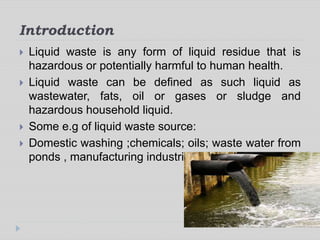Not known Factual Statements About Reclaim Waste
Not known Factual Statements About Reclaim Waste
Blog Article
The Single Strategy To Use For Reclaim Waste
Table of ContentsThe Definitive Guide to Reclaim WasteThe Buzz on Reclaim WasteOur Reclaim Waste IdeasReclaim Waste Fundamentals ExplainedReclaim Waste Fundamentals Explained
Discover the types, occurrences, and types of liquid waste. Residential sewage waste describes the waste and items from a household septic system. This kind of waste is produced by humans in homes, schools, and various other buildings. This only includes sewage-disposal tanks that have a drainpipe area. The proper management and disposal of residential sewer waste require fluid waste to be transferred to a sewage therapy plant where the proper techniques and tools are related to detoxify and dispose of waste.
Commercial waste usually includes prospective threats, such as flammable materials or a mixture of fluid and strong waste products, and calls for a much more innovative and detailed disposal procedure. The disposal of commercial waste normally involves the filtration of waste prior to transport to make certain secure and proper disposal. Industrial waste is produced from by-products and overflow of commercial procedures and production.
This kind of waste can not utilize the same sewage administration transport or procedures as septic or commercial liquids. The hazardous waste monitoring procedure calls for the inspection and screening of liquid waste before it undergoes the disposal process (liquid waste disposal). Runoff waste is the liquid waste that comes from overflow and excess stormwater in very populated locations or cities
Runoff waste can trigger contamination and flooding otherwise taken care of effectively. Find out more concerning drain cleaning and waste monitoring. Making certain appropriate waste administration can protect against disasters and reduce ecological injury. Both people in household setups and specialists in business or manufacturing markets can gain from understanding the processes and laws of fluid waste administration.
Facts About Reclaim Waste Uncovered
Contact PROS Solutions today to learn more about our waste administration and disposal services and the correct ways to take care of the fluid waste you create.
(https://slides.com/reclaimwaste1)Do you know what occurs to your water when you disengage, purge the toilet or drain the cleaning maker? No? Well, it deserves recognizing. This so-called 'wastewater' is not just a crucial source but, after therapy, will be launched to our land, waterways or the sea. Utilized water from toilets, showers, bathrooms, kitchen sinks, washings and industrial procedures is called wastewater.

water made use of to cool machinery or tidy plant and tools). Stormwater, a type of wastewater, is drainage that moves from agricultural and metropolitan locations such as roofing systems, parks, yards, roads, paths and rain gutters right into stormwater drains pipes, after rain. Stormwater streams untreated directly to regional creeks or rivers, at some point reaching the ocean.
Some Ideas on Reclaim Waste You Should Know
In Queensland, most wastewater is treated at sewage therapy plants. Wastewater is carried from domestic or commercial sites through a system of sewers and pump stations, understood as sewerage reticulation, to a sewer therapy plant.
The Department of Natural Resources advises neighborhood federal governments about handling, operating and preserving sewage systems and treatment plants. In unsewered areas, city governments might require householders to set up individual or house sewage therapy systems to treat domestic wastewater from commodes, kitchen areas, shower rooms and laundries. Click This Link The Department of Natural Resources authorizes the usage of house systems when they are verified to be effective.
Most stormwater obtains no treatment. In some new communities, treatment of some stormwater to eliminate clutter, sand and gravel has begun using gross toxin traps. Wastewater treatment takes place in 4 stages: Gets rid of strong matter. Larger solids, such as plastics and other things incorrectly released to drains, are removed when wastewater is passed via displays.
Utilizes little living microorganisms knows as micro-organisms to break down and eliminate staying liquified wastes and great fragments. Micro-organisms and wastes are incorporated in the sludge.
Reclaim Waste for Beginners
Nutrient elimination is not readily available in all sewage treatment plants because it needs costly specialised devices. It is coming to be more usual in Queensland. Clear fluid effluent produced after therapy may still consist of disease-causing micro-organisms. If this effluent is launched right into waterways such as rivers or the sea, the micro-organisms will at some point pass away out.

The majority of wastewater moves into the sewerage system. Under the Act, regional federal governments provide approvals and licences for eco appropriate activities (ERAs) involving wastewater releases that could have a local impact.
Some Of Reclaim Waste
Otherwise, examples are considered research laboratory analysis. Typically numerous examinations are needed to develop the levels of each of the various toxins such as oils, heavy steels and chemicals in water. Surveillance supplies accurate details concerning water quality and can verify that permit conditions are being satisfied. The details acquired via monitoring supplies the basis for making water quality choices.
Report this page